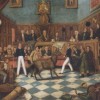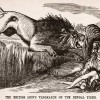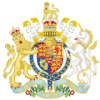A Victorian Menagerie in an Historical Context
Created by Catherine Golden on Sat, 03/28/2020 - 13:38
Part of Group:
The Victorian era witnessed the rise of animal protection, zoos, pet keeping, natural history, cattle and sheep breeding, vegetarianism, antivivisection, and dog and cat shows. But it also beheld big game hunting, blood sports, animal abuse, a burgeoning fashion industry that threatened animal populations, and widespread fears of our animal ancestry, sparked by Darwinian evolution. Animal artists drew exotic specimens and animals of all species observed from life and on location. In addition, artists and authors humanized animals or dressed them in Victorian clothes to point out social vices as well as rampant inequalities across the social classes in regard to wealth, education, and quality of life in general. Students in the "Victorian Illustrated Book" class at Skidmore College selected items to add to this chronology to set our gallery exhibit, "A Victorian Menagerie," in a cultural context.
Timeline
Chronological table
|
Date |
Event | Created by | Associated Places | |
|---|---|---|---|---|
| 5 May 1809 |
Erskine anti-animal-cruelty speech
On this date, a former Lord Chancellor known for progressive advocacy, Lord Thomas Erskine, gave a subsequently famous speech in Parliament arguing for England’s first prevention of cruelty to animals bill, one primarily designed to curb the beating and abuse of horses and cattle (entitled “An Act to prevent malicious and wanton Cruelty to Animals”). Erskine was far from demanding full rights or legal protection for horses, simply that we should be obligated to keep animals under our protection from unnecessary pain. Erskine’s bill was defeated at the committee stage due in part to the strong counter-arguments made by Whig M.P. William Windham, an opponent of Evangelical encroachments on traditional English sports and practices. ArticlesRelated ArticlesSusan Hamilton, “On the Cruelty to Animals Act, 15 August 1876″ Philip Howell, “June 1859/December 1860: The Dog Show and the Dogs’ Home” Mario Ortiz-Robles, “Animal Acts: 1822, 1835, 1849, 1850, 1854, 1876, 1900″ |
David Rettenmaier | ||
| 22 Jul 1822 |
Richard Martin's Act
The painting depicts the Trial of Bill Burns, the first prosecution under the 1822 Martin's Act for cruelty to animals, after he was found beating his donkey. It is the first known prosecution for animal cruelty in the world. The prosecution was brought by Richard Martin, MP for Galway, also known as Humanity Dick, and the case became memorable because he brought the donkey into court. The painting was made at the time of the trial. ArticlesRelated ArticlesSusan Hamilton, “On the Cruelty to Animals Act, 15 August 1876″ Philip Howell, “June 1859/December 1860: The Dog Show and the Dogs’ Home” Mario Ortiz-Robles, “Animal Acts: 1822, 1835, 1849, 1850, 1854, 1876, 1900″ |
David Rettenmaier | ||
| 16 Jun 1824 |
Society for Protection of Animals foundedOn 16 June 1824, founding of the Society for the Protection of Animals (SPCA) in London. The Society became the Royal Society in 1840, when it was granted a royal charter by Queen Victoria, herself strongly opposed to vivisection. ArticlesRelated ArticlesSusan Hamilton (U Alberta), “On the Cruelty to Animals Act, 15 August 1876″ Philip Howell, “June 1859/December 1860: The Dog Show and the Dogs’ Home” Mario Ortiz-Robles, “Animal Acts: 1822, 1835, 1849, 1850, 1854, 1876, 1900″ |
David Rettenmaier | ||
| The end of the month Spring 1828 |
Opening of the London ZooThe London Zoo opened in 1827 as a place for scientific study. Animals from the Tower of London menagerie came to the London Zoo shortly after in 1831-32. The zoo opened to the general public in 1847. A trend setter, this zoo, now also known as the Regent's Park Zoo, is known for establishing the first reptile house (1849), public aquarium (1853), insect house (1881), and children’s zoo (1938). |
Catherine Golden | ||
| The end of the month Spring 1828 |
London Zoo in Regent's ParkClick on the map to get close to the London Zoo and its location in Regent's Park. |
Catherine Golden | ||
| 1837 |
Gould's "The Birds of Europe"Available on the non-profit Internet Archive, naturalist artist John Gould's The Birds of Europe (1837) uniquely catalogued local as well as exotic bird species. Gould believed local species should be given the same attention as their more exotic counterparts, and his meticulous, full-color illustrations garnered much appreciation and persuaded many readers to his way of thinking. Following the creation of this and other ornithological encyclopedias, bird-watching as a hobby came into popularity. |
Rose O'Gara | ||
| 22 Aug 1857 |
John Tenniel’s “The British Lion’s Vengeance on the Bengal Tiger”
Related Articles |
David Rettenmaier | ||
| 1859 |
Darwin's "On the Origin of Species"Hailed as the foundation of evolutionary biology, Charles Darwin's On the Origin of Species explained the theory of natural selection and popularized Herbert Spencer's phrase "survival of the fittest." Written for the scientific community and the general public, the book appealed to a wide audience and generated scientific, philosophical, and religious discussion. |
Rose O'Gara | ||
| 15 Aug 1876 |
Cruelty to Animals Act
ArticlesSusan Hamilton, “On the Cruelty to Animals Act, 15 August 1876″ Related ArticlesPhilip Howell, “June 1859/December 1860: The Dog Show and the Dogs’ Home” Mario Ortiz-Robles, “Animal Acts: 1822, 1835, 1849, 1850, 1854, 1876, 1900″ |
David Rettenmaier | ||
| circa. 1892 |
Beatrix Potter studies fungiBeatrix Potter became very interested in studying fungi and produced many of her famous naturalistic drawings of plant life at this time. Potter and her drawings were not taken seriously by the Linnaean Society because she was a woman, which separated her from the scientific community. Later, we see the plants that Potter had studied and sketched featured in her illustrated picture books. |
Meesha Ryan | ||
| 1901 |
Beatrix Potter Self-PublishesInitially, Potter struggled to find a publishing house that would agree to publish her story. As a result, Potter decided to self-publish The Tale of Peter Rabbit. She originally illustrated it with black-and-white drawings. |
Meesha Ryan | ||
| 1902 |
Beatrix Potter Publishes "The Tale of Peter Rabbit" with Frederick WarneAfter self-publishing The Tale of Peter Rabbit the year before, Potter was asked to color her images and publish the story with publishing company Frederick Warne. Her books proved themselves to be very successful, and Potter had a long buisiness relationship with Warne, who continued to publish her children's storybook series. |
Meesha Ryan | ||
| 1905 |
Establishment of the Audubon SocietyFounded with the mission to protect and preserve birds and their ecosystems, the Audubon Society focused their conservation efforts strongly on the species of waterbirds--such as egrets, terns, and herons--whose feathers were most employed by the millinery trade. The society is named after naturalist artist John James Audubon, who catalogued and painted over 1,000 species of birds and compiled them into an encyclopedia. Still in existence today, the Audubon Society fights for legislation to protect birds and their environments, such as the Endangered Species and Clean Air acts. |
Rose O'Gara |









